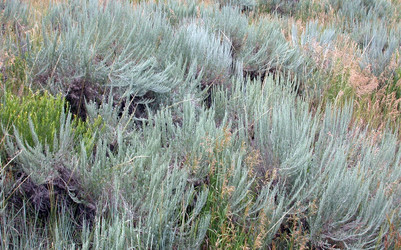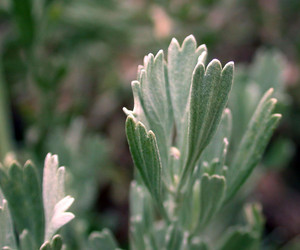Lakota name: pۦejiَ hớta tatan ka (means big grey herb) Listen to Lakota Plant Name: pۦejiَ hớta tatan ka
Listen to Lakota Plant Name: pۦejiَ hớta tatan ka
Scientific name: Artemisia tridentata
Common names: Sagebrush, Big Sagebrush, Common Sagebrush, Blue Sagebrush, or Black Sagebrush
Medical uses: Sagebrush was widely used by many native North American Indian tribes for a wide range of disorders. It is little used in modern herbalism, though it certainly deserves further investigation. The plant is antiseptic, digestive, disinfectant, febrifuge, ophthalmic, poultice and sedative. A decoction (boiling) of the leaves is used in the treatment of digestive disorders and sore throats. An infusion of the fresh or dried leaves is used to treat pneumonia, bad colds with coughing and bronchitis. It is used both internally and externally in the treatment of rheumatism. The crushed plant is rubbed on cuts, sores etc. Steeped leaves are applied to sore eyes. The plant is burnt in the house in order to disinfect it. An infusion of the leaves is used as a hair rinse, it treats dandruff and falling hair An infusion of the plant repels insects, it is also a disinfectant and so is used for washing walls, floors etc. A yellow to gold dye is obtained from the leaves, buds and stems combined.
Edible parts: leaves, seeds
Edible uses: Leaves are cooked. The subspecies A. tridentata vaseyana has a pleasant mint-like aroma whilst some other subspecies are very bitter and pungent. The leaves are used as a condiment and to make a tea. It can be roasted then ground into a powder and mixed with water or eaten raw. The seed is very small and fiddly to use.
Other uses: basketry, dyes, fiber, friction sticks, fuel, hair, paper, repellent, stuffing, and tinder. The fibrous bark is used for weaving mats, baskets, cloth etc., or as a stuffing material in pillows etc. and as an insulation in shoes to keep the feet warm. A fiber obtained from the inner bark is used for making paper. The fibers are about 1.3 mm long. A bunch of the leafy stems can be tied together and used as a broom. The shredded bark is a fine tinder for starting fires. The stems make good friction sticks for making fires. The seeds are used during celebrations because, when thrown into a fire, they explode like crackers.
Wood: It is hard and dense. It burns rapidly and well, even when green, and has a pleasant aromatic smell.
Smells: After you crush the leaves, they are very aromatic, especially after rain.
Paper preparation: The stems are harvested in late summer, the leaves removed and the stems steamed until the fibre can be stripped off. The fibre is then cooked for two hours with lye before being ball milled for 4 hours. The resulting paper is a light tan/gold color.
Unknown facts: Although no reports of toxicity have been seen for this species, skin contact with some members of this genus can cause dermatitis or other allergic reactions in some people.
Description: A shrub or small tree from the family Asteraceae. It is a hardy silvery-grey bush with yellow flowers and grows in arid sections of the western US. It is the primary vegetation across vast areas of the Great Basin desert, along rivers or in other related wet areas. Sagebrush can grow as tall as 3 m but is more typically 1-2 m tall. Sagebrush has a strong pungent fragrance, especially when wet, which is not unlike common sage. It also has a bitter taste. Sagebrush leaves are wedge-shaped 1-4 cm long and .3-1 cm broad. The outer and wider end is generally divided into three lobes. Leaves are covered with fine slivery hairs.



Artemisia tridentata plants and close-up of leaves, images © Mary Ellen (Mel) Harte
Some botanists treat it in the segregate genus Seriphidium, as S. tridentatum, but this is not widely followed. The name "sagebrush" is also used for several related members of the genus Artemisia, such as California Sagebrush (Artemisia californica). It is hardy to zone 8 and is frost tender. It is in leaf all year, in flower in October, and the seeds ripen from October to November. The flowers are hermaphroditic (have both male and female organs) and are pollinated by wind.
The plant prefers light (sandy) and medium (loamy) soils, requires well-drained soil and can grow in nutritionally poor soil. The plant prefers acid, neutral and basic (alkaline) soils and can grow in very alkaline soil. It cannot grow in the shade. It requires dry or moist soil and can tolerate drought. Sagebrush flowers in the late summer or early fall. The flowers are yellow and are carried in long, slender clusters.
Range: Western N. America - It is found in the Black Hills. It is very rarely seen in the higher altitudes/meadows of the Black Hills.



 Go to quick links
Go to quick search
Go to navigation for this section of the ToL site
Go to detailed links for the ToL site
Go to quick links
Go to quick search
Go to navigation for this section of the ToL site
Go to detailed links for the ToL site